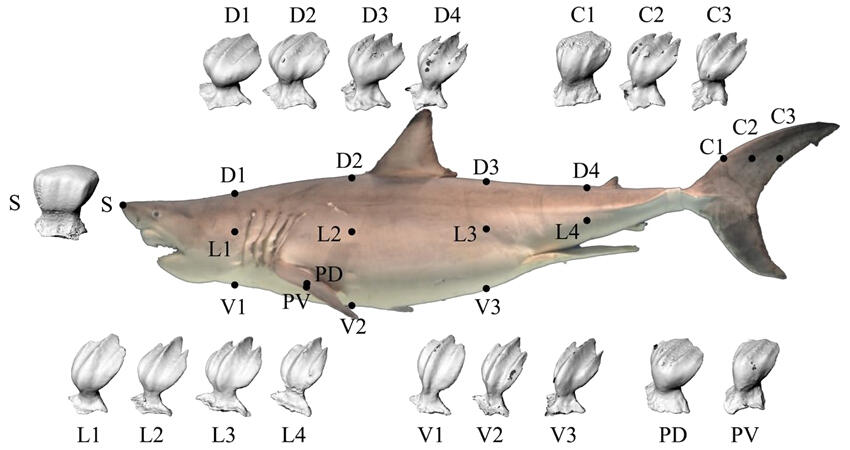A research team led by Graduate Student Shotaro Sayama (at the time of research) and Associate Professor Hiroto Tanaka of the Department of Mechanical Engineering, School of Engineering at the Institute of Science Tokyo (Tokyo Institute of Technology at the time of research*) revealed that the dermal denticles of the great white shark adapt to a wide swimming speed range from high to low speeds. The epidermis was collected from 17 positions of the body. The shapes of dermal denticles (or placoid scales; hard scales found in the cartilaginous fishes, such as sharks and rays) were measured in detail using X-ray computed tomography (CT). The conclusion of this study was drawn by devising a method to hydrodynamically calculate the optimum swimming speeds of sharks based on the distance between the high and low ridges on the dermal denticles. The research team also applied this method to calculate the swimming speed of an extinct giant shark called megalodon from fossil denticles and estimated body length. The results suggested that its speed was not much different from that of the great white shark, despite its large body. This research was undertaken by a collaborative group including Specially Appointed Department Head Masahito Natsuhara of Shimadzu, Senior Curator Gento Shinohara of the National Museum of Nature and Science, and Associate Professor Masateru Maeda of Takushoku University, and published in Journal of the Royal Society Interface, an international journal, on August 2.

Provided by Institute of Science Tokyo
Sharks are covered with hard scales called dermal denticles, and the dermal denticles of migratory sharks have ridges running from head to tail. These ridges are widely known as the source of inspiration for riblets (a set of tiny rows of protrusions on the surface of an object) that reduce the frictional drag of the turbulent boundary layer on the surface of an object. Surprisingly, the hydrodynamic sizes of dermal denticles as riblets had not been investigated previously, and it remained unknown whether the dermal denticles actually reduce hydrodynamic drag when sharks are swimming. Moreover, despite its high visibility, specimens of and ecological data on the great white shark are scarce. The function of combinations of higher middle ridges (high ridges) and lower ridges on their left and right sides (low ridges) on dermal denticles was also unclear.
In this study, epidermis samples from 17 locations were collected from a formalin immersion specimen of the entire body of the great white shark (3.16 m in length and 320 kg in weight) owned by the National Museum of Nature and Science. The samples were measured using high-resolution X-ray CT for three-dimensional modeling. The group devised a method to hydrodynamically calculate the optimum swimming speeds of sharks based on the distance between high and low ridges on the dermal denticles.
The optimum swimming speed at which the fluid frictional drag was reduced to a minimum was calculated from the distance between the dermal denticles and the tip of the body and the ridge spacing, considering the denticle ridges as riblets. According to the calculation, adjacent high and low ridges were suitable for swimming speeds of 5-7 m/s, and high ridges with a large spacing were suitable for swimming speeds of 2-3 m/s. These values are close to the recently recorded maximum instantaneous and long-distance migration speeds of wild great sharks, indicating that the left and right lower ridges are suitable for high-speed swimming, whereas the higher middle ridge is suitable for slow swimming. This equation allows hydrodynamical estimation of swimming speeds of ancient sharks based on the shape of denticle ridges and total body length, which is expected to advance research on shark ecology and evolution.
Moreover, the group proposed a model in which the riblets with alternating high and low ridges were used to reduce drag at high and low speeds. The proposed model is expected to facilitate the development of riblets that are adaptable to various speeds and applicable to vehicles, ships, and aircraft.
Tanaka said, "This great white shark specimen was displayed at the National Museum of Nature and Science for the "Hunters of the Ocean" exhibition in 2016. In the fall of that year, the specimen was moved to the Okinawa Churashima Foundation Research Institute. There was an opportunity to remove formalin from the specimen in preparation for an exhibition at the Okinawa Churaumi Aquarium. Dr. Gento Shinohara, a co-author of the paper, invited me to take advantage of this rare opportunity and measure whole-body morphology. In response, I proposed sampling the skin surface morphology and this is how this project began. I thought I had a valuable opportunity because I wanted to study the effects of the body surfaces of living organisms on fluid drag."
* Tokyo Institute of Technology and Tokyo Medical and Dental University merged into the Institute of Science Tokyo on October 1st, 2024.
Institute of Science Tokyo's English press release: https://www.titech.ac.jp/english/news/2024/069682
Journal Information
Publication: Journal of the Royal Society Interface
Title: Three-dimensional shape of natural riblets in the white shark: relationship between the denticle morphology and swimming speed of sharks
DOI: 10.1098/rsif.2024.0063
This article has been translated by JST with permission from The Science News Ltd. (https://sci-news.co.jp/). Unauthorized reproduction of the article and photographs is prohibited.




